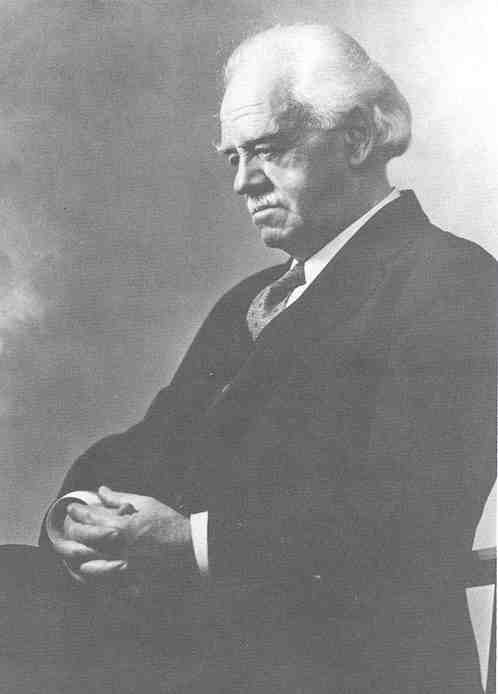Ernest M. Skinner
Title
Creator
Identifier
Text Record
Subjects
People
Collection
Full Text
Ernest M. Skinner
by Stanley Russell Howe

Ernest Martin Skinner
1866-1960
In Bethel’s Woodland Cemetery, not far from the Gothic Revival tomb, is the grave of Ernest M. Skinner, one of America’s leading organ makers whose fame spread across the Atlantic. Skinner married a Bethel woman, Mabel Hastings, in 1893 at the Hastings family homestead on Broad Street, and lies near the Hastings family lot with her.
Ernest Martin Skinner was born in Clarion, PA, the son of touring concert singers Washington and Alice Skinner. Washington Martin Skinner was born in 1836 in Lowell, MA, and his wife Alice Frances Brett was born in 1844 in Houlton, ME. They were married in Marlboro, MA, in 1864; Ernest appeared in 1866 as their first child. Another son , Harry Clifford Skinner, was born two years later in Craftsbury, VT, where his parents were apparently on another concert tour.
From an early age, Ernest Skinner showed a strong interest in the production of sounds. In fact he tried to make music from almost anything his hands touched. When he was seven, his parents gave up their nomadic musical life and settled down in Taunton, MA, presumably so the two sons could obtain their schooling. It was Ernest’s father who fostered his interest in music through the music company he organized in Taunton. Here he attended rehearsals and performances of Gilbert and Sullivan operas, which stimulated his consuming interest in music and became the motivating force for his creative spirit.
When Ernest was a teenager, the family moved to West Somerville, MA, where he attended high school for approximately six months. In his Autobiography, he stated that the reason for leaving his schooling was his inability to understand Latin, but Dorothy Holden in her biography, The Life and Work of Ernest M. Skinner, attributes it to the fact that the family fortunes declined precipitously and Ernest was obliged to assist in supporting the family. It was during this time that Ernest saw his first pipe organ and later got a job as a bellows pumper at fifteen cents per hour. He also repaired his first organ at this early stage of life.
Frustrated by his lack of finding a niche during these years, Ernest became a “shop boy” for George H. Ryder, a small organ builder located in Reading, MA. It was here that Ernest’s interest in organs began to be take shape. After four years here, Ernest was summarily fired one morning. This departure proved fortuitous for it soon meant that he would work for Jesse Woodbury of Boston briefly and then the George S. Hutchings Organ Company from 1889 to 1901. In 1898, he traveled abroad to the United Kingdom, the Netherlands, and France to learn all he could from European organ builders.
In 1901, he decided to strike out on his own by developing his dream of a more expressive pipe organ by exploiting all the benefits to be gained by the “new” electro-pneumatic action. He either developed or greatly refined entirely new families of stops for the pipe organ. Skinner’s strengths were not as a businessman, but as a creator of rich organ sounds. He frequently spent more on his organs than he charged for them and occasionally delivered them behind schedule. His immaculate workmanship, clever innovations, and magnificent tone, however, consistently attracted more customers.
His fortunes took a turn for the better in 1919 when the millionaire chemist and organ aficionado Arthur Hudson Marks (1874-1939) bought the controlling interest in the company, and reorganized, streamlined, and capitalized the entity as the Skinner Organ Company. Skinner made a trip in the 1920s to the factory of Henry Willis III in England to study new ideas in the tonal designs of organs. When he returned home, he incorporated many of these ideas into his organ building.
In 1927, G. Donald Harrison, an outstanding employee of Henry Willis’, was hired by Marks to help Skinner improve the tonal design of his organ. Skinner welcomed the younger man into his company, but the good relations did not endure. In 1930, tensions between the two men were rife. The stock market crash the previous year did little for the company fortunes as well; sales fell from $1.4 million in 1928 to only $604,000 in 1931.
Skinner sold his stock in the company in 1930 and planned to start a rival organ building firm. Fearing the potential negative effect of such a move, Marks and his board offered Skinner $5,000 per year for five years to do little except keep his association with the Company. When the agreement ended, Skinner left the company to found his own with his son Richmond.
The new firm built a large organ for the National Cathedral in Washington, DC, in 1937 as well as several other new and many rebuilt instruments. By 1949, Ernest completely retired from the organ business. The organ building business had completely changed and Skinner was decidedly out of favor. Sadly, many of his masterpieces were replaced with more fashionable instruments that represented what was in favor at the time. Skinner’s wife, Mabel, died in 1951. He lived on to the age 94, dying in 1960.
Today many of Skinner's organs have been or are being painstakingly restored to their former Skinner glory. The Skinner organ in Severance Hall in Cleveland just recently underwent such a transformation. One of the most carefully maintained Skinner organ is at Woolsley Hall at Yale. Today he is recognized as one of the leading organ builders in the United States, fully living up to the epitaph on his gravestone at Woodland Cemetery: “Great American Organ Builder.”
